Satellite on a string or space cable systems
When it comes to space tether systems, space elevators and other cyclopean structures are usually remembered, which, if built, will be in the very distant future. But few people know that experiments with the deployment of ropes in space were carried out repeatedly, with different goals, and the last one ended in failure in early February of this year.
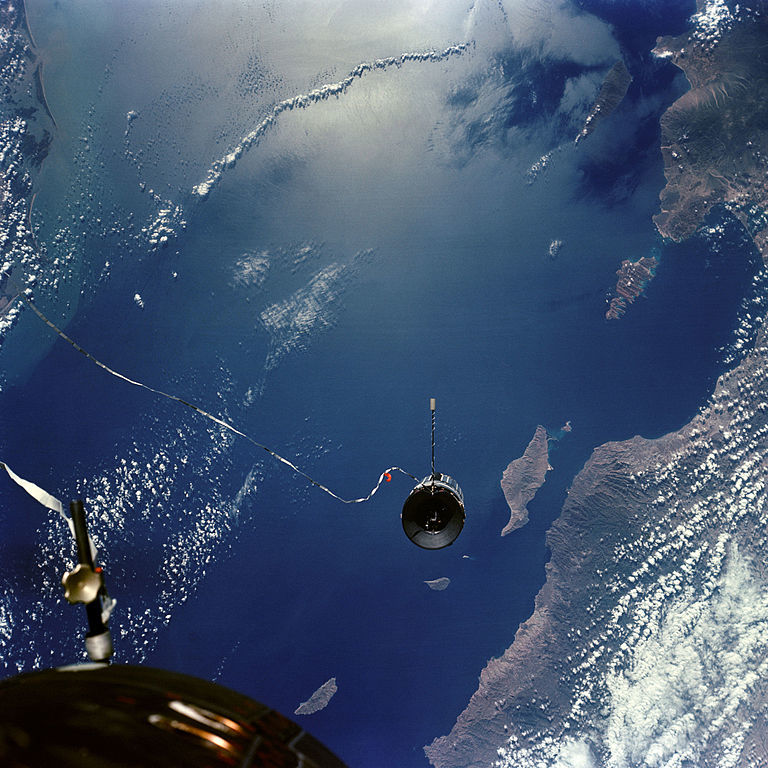
“Gemini 11”, connected by a cable with a target “Agena”, photo by NASA.

HTV-KITE Experiment as an Artist, Photo by JAXA
On January 27, the cargo ship HTV-6 undocked from the ISS. But instead of going straight back to the fiery embrace of the atmosphere, the ship moved to a lower orbit of 360x370 km. On it, the HTV-6 could not interfere with the ISS. It was expected that within 24 hours after undocking the truck would unfold a seven-meter-long cable and begin a weekly program of experiments. But, according to media reports, the ground control center of flights could not receive confirmation of the separation of the end cargo from the ship - it seems that at least one of the four locks did not open. To inspect the department, the engineers wanted to use a specially installed camera and built-in optical instruments for the approach and docking system. The Japanese space agency did not issue official updates on the state of the experiment, but according to interviews with its media representatives, confirmation of the separation of the end cargo was never received. They did not extend the flight of the ship, so on Saturday, the ground control center gave the command to cut the cable so that the possibly unfolded cable did not interfere with orbital operations. If the cable had at least moved from its place, then after cutting it would have been noticed as a separate object of the means of control of outer space. Unfortunately, nothing new in orbit has been fixed, which means that the cargo has not really separated from the ship. And what, actually, did they want to check in the HTV-KITE experiment?
')

Experiment equipment HTV-KITE, photo JAXA
The idea of the experiment was very beautiful. A metal cable 720 meters long with an end weight of twenty kilograms was installed on the cargo ship. The spring plunger had to provide an initial unwinding speed of 1 meter per second. Reflectors were installed at the end of the load, which would be visible to the additional camera and the standard optical system for approaching and docking the ship. It is the capabilities of the docking system that determined the maximum length of the cable - the engineers wanted to know exactly the position of the end load and the distance to it. After reaching a length of 710 meters, a mechanical brake should have been activated, which would stop the cable unwinding. A fully unwrapped metal cable with a special conductive coating would become a very long conductor and could interact with the Earth’s magnetosphere. And here came the most interesting. A field emission cathode was supposed to create a potential difference between the load and the ship. From this a current would begin to flow along the cable, which, interacting with the magnetic field of the Earth, should have caused the Lorentz force, braking the ship and cargo.
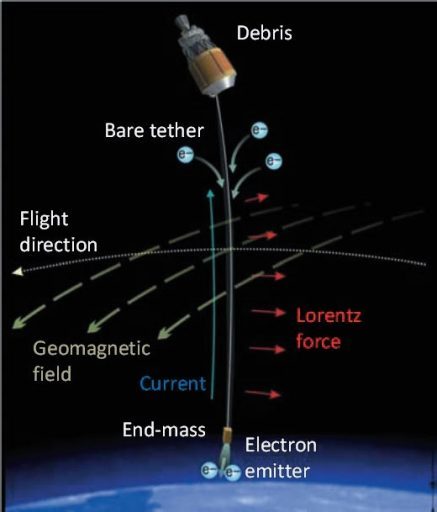
The result should have been a simple, not requiring control of orientation in space and a system that consumes a minimum of energy for the orbit of space debris. In general, the movement of current in the cable can be reversed and accelerated, raising the orbit due to the waste of electricity, but Japanese engineers were only interested in descending from orbit. The location of the devices and their work are clearly shown in the November video from JAXA. There is only Japanese text, but almost everything is clear from the pictures.
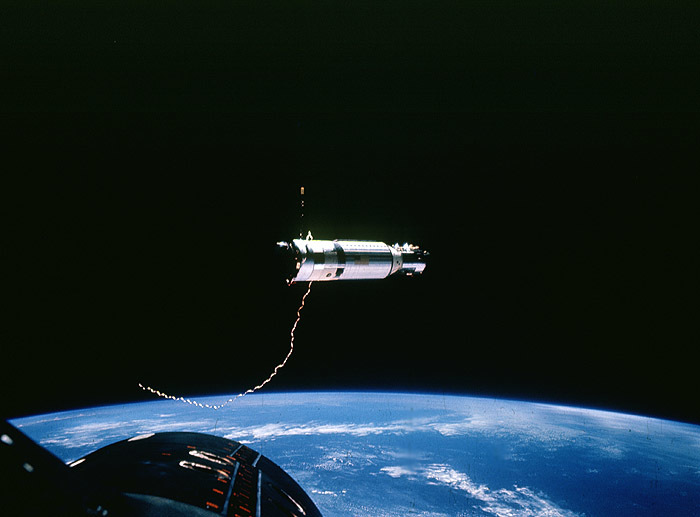
Target "Agena" after the separation of the cable. NASA Photos
Historically, the first experiment on Gemini 11 (astronauts Pete Conrad and Richard Gordon) in September 1966. One of the mission’s secondary tasks was to manually pick up a thirty-meter cable to the Agen target and, after undocking, to see how the two connected objects behave in orbit. First, piloting Gemini Konrad tried to put the bundle into gravitational stabilization mode, so that the target was at the bottom, the ship was at the top, and the cable was taut. But this did not work out - when you try to disperse by 30 meters, oscillations began. But the task of creating a small weight by rotating the ligament did not cause any problems. The cable that bent at first, straightened, and, turning at 55 ° per minute, the bundle created 0.00015 (according to other data 0.00078) g. The man did not feel this, but things floating around the cabin gradually settled on the bottom of the capsule.
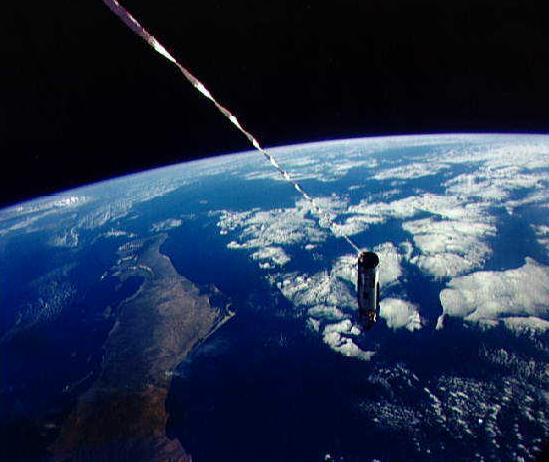
Bundle "in work", the cable is taut. NASA Photos
In addition to photos, astronauts filmed the video, and it is clearly visible and vibrations and rotation (from 10:45)
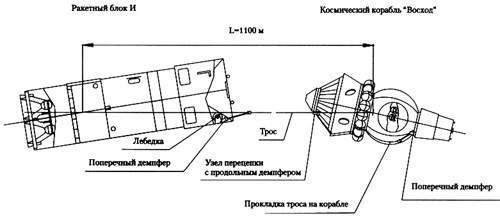
Scheme of the cable system "Voskhoda"
A much more complicated scheme was developed in the USSR for one of the flights of the Voskhod ship. After entering orbit and separation from the third stage, the ship would remain attached to it by a cable. Then the stage had to turn on the solid-fuel engines for the divergence at a speed of 10 meters per second. To dampen possible oscillations, they were going to stage their control system with orientation engines (it was originally from the ship). Moving a kilometer away, the stage would slow down the unwinding of the cable and include another set of engines for promotion at a speed of 2 revolutions per minute, creating a gravity of 0.003 earth. Then, on the ship, an intercept system would be activated, which would turn the ship around so that the astronauts would be accelerating against the seats, and not vice versa. And finally, to create lunar gravity, the winch would tighten the cable, reducing the length of the bundle, and, according to the law of conservation of angular momentum, accelerating the rotation. But this design did not fly into space - the Voskhod ships stopped flying after a long Kosmos-110 mission with dogs, and the system could not be transferred to Soyuz, so the project was eventually closed.
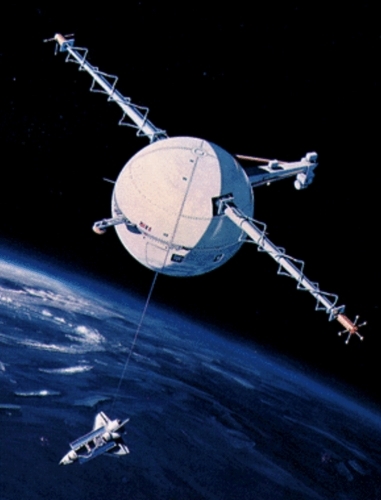
Experiment TSS-1 in the view of the artist, photos NASA
Experiments with cables in NASA and the Italian Space Agency were offered as early as the 1970s, but they only matured into practical implementation only twenty years later. In 1992, to test stabilization by the gravitational gradient method, as well as the study of near-earth plasma and the processes that will occur on the end load and in the cable, the shuttle Atlantis (mission STS-46) went into space. According to the plan, the cable should have turned as much as twenty kilometers, but this was not possible. The unwinding of the cable got stuck at 78 meters, then when the problem was fixed, the cable got stuck again at 256 meters, and it didn’t work further. But the data obtained on such a small database turned out to be promising, and the experiment was repeated on the shuttle Columbia in 1996 on the STS-75 mission.
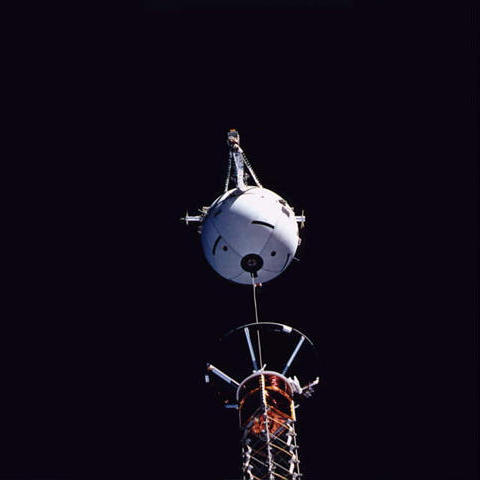
The very beginning of the cable unwinding, photo by NASA
At first everything went well, and, very slowly, the cable was already unwound up to 19 kilometers from the planned twenty, the equipment recorded three times more current than expected by the design models, but then the cable suddenly broke. Then, already on the ground, it turned out that during the process of unwinding, gas bubbles in the cable insulation of the cable began to burst. The free atmosphere near the conductor with a voltage of 3500 volts became plasma and closed the cable to the experimental equipment farm. The resulting short circuit melted a portion of the cable, breaking it. Despite the formal failure, during the unwinding of the cable, a lot of interesting data were collected - physics of the behavior of cable systems, data on the plasma environment and potential difference in the cable.
Video experiment (from 2:45).
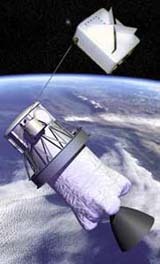
SEDS Experiment as an Artist, NASA Photo
In 1993 and 1994, NASA conducted three successful experiments, adding cable systems to the top stage of the Delta-II booster. The cable began to unwind after separation of the main payload when the step became useless trash. In the SEDS and SEDS-2 experiments, a cable 20 km long was unwound. The load was pushed down, therefore, due to the gravitational gradient effect, the bundle began to rotate, keeping the vertical direction to the center of the Earth. Due to the rotation, the speed of the load relative to the Earth was less than the speed of the step, therefore, when the cable was cut, the load moved to the deceleration trajectory, and the step rose slightly higher. In the first experiment, the calculation turned out to be accurate, and the employee, who was specially directed to the intended location of the fall of the load, was able to photograph its combustion in the atmosphere. In the second experiment, the load was not dropped. He came off with a piece of cable three days later, and the remaining piece along with the stage flew for several more months. And finally, in the third PMG experiment, using a relatively short five-hundred-meter cable, the ability to both extract electricity from the magnetosphere was slowed down and accelerated by applying energy to the cable.
In 1996, the TiPS technical demonstrator deployed a 4 km long cable, on which two satellites flew around the Earth for ten years, surpassing the calculations by five times. This mission showed that the fast breakage of the SEDS-2 was most likely an accident, and you can fly on the cable for a long time. But the subsequent experiment ATEx was unlucky - due to the unexpected behavior of the cable during unwinding, it was crashed after only 18 meters.
The experiment of the European Agency YES in 1997 did not even begin to unwind the cable due to the fact that it was placed into an inappropriate orbit. But ten years later, YES2 was a very interesting experiment, a success that ended, albeit from indirect data.
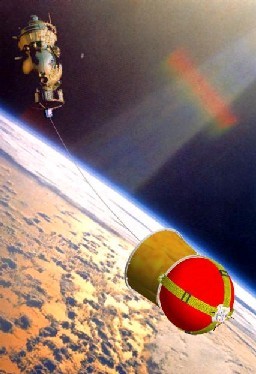
Unwinding of cable YES2 in the artist's view
A small Photino capsule with thermal protection was installed on the Russian Foton-M3 scientific apparatus.

On the left is the development team, on the right is the placement of the capsule on the Fotone M3
The cable was supposed to unwind in two stages - 3400 meters and 31.7 kilometers. After the cable was completely unwound, it would have been cut off, and the Photino would have landed in a certain area of Kazakhstan. However, after the experiment, the descent vehicle could not be found. The data from the winch were damaged due to improper operation of the equipment, but when they were decrypted, it was possible to establish that the cable was nevertheless unwound to its full length and dropped at the right time. Fotino was not found in orbit, but Foton-M3 received the expected acceleration, and its orbit rose slightly. So, Fotino successfully descended from orbit along the correct trajectory. What happened next is unknown. It could burn in the atmosphere (the capsule was also experimental) or drown in the Aral Sea (the trajectory passed not far). But, despite the loss of the descent vehicle, the experiment was successful, and the record of the length of the cable has not been beaten yet.

Trajectory "Fotino" on the cable according to the decoded data. On the right is Mount Everest for scale. ESA Photos
An animation of the mission. The real trajectory in the figure above coincided with the expected one.

MAST experiment as an artist
Small and relatively cheap Kubsat became attractive carriers for cable experiments, but the mission so far ends in accidents. In a very interesting experiment, MAST had to use three nanosatellites - two were separated by a distance of 1 km on a cable, and the third would have to drive it. Unfortunately, after launching into orbit, it was possible to establish communication only with the third satellite, and, despite the software that the cable had to deploy, even in the absence of communication, it was released only one meter instead of a kilometer. The Japanese STARS experiment in 2009 was also unable to release the cable due to the failure of the locking mechanism. In the subsequent experiment, STARS-II failed to obtain confirmation of the release of the cable. On the one hand, a bunch of two cubsat left the orbit faster than other cubsat deduced by the same rocket. On the other hand, a telescopic photograph from Earth showed them with one object, not two. And finally, the Estonian nanosatellite ESTCube-1 in 2013 simply failed to unwind the cable.

Illustrations for Russian projects, photo by RSC Energia
In the second half of the 90s, RSC Energia developed projects of cable systems using orbital stations - Tros-1, Tros-1A. In the first experiment, they wanted to connect the Mir station and the Progress ship with a 20 km cable. After some time, the cable would have been cut, Progress would have moved to a lower orbit, and Mir would be cut to a higher one. In the experiment “Tros-1A”, the length of the cable would be increased to 50 km, in this case “Progress” would descend from orbit, and “Mir” would rise by 10 km and save 400 kg of fuel to maintain orbit. In addition, together with the European Space Agency, the Tpoc-Rapunzel project was developed. None of these projects has been implemented. However, the idea of cables in space is not thrown away at all. It turns out that the plans of the Russian segment of the ISS include the experiment "Tros-MSTU" with the deployment of a cable length of 5 km from the "Progress". The experiment was included in the plan in 2009 and was planned in 2016. Unfortunately, there is no news on it after 2014, but I also could not find information about its cancellation.
Simple designs with small loads and very short cables are widely used in astronautics to slow down or stop rotation. The fact is that stabilization by rotation is a very simple and often used way to maintain the desired position in space. But for the work of tools like a camera, it is better to stop the rotation or at least slow down. For this purpose, the law of conservation of angular momentum is used - if from a rotating satellite or a rocket we start unwinding the cables with a load to the sides, its rotation will slow down.
Ground based experiment.
On a geophysical rocket (from 1:26).
In general, the use of ropes in astronautics can be useful. Experiments have shown that they can be used to study the Earth’s magnetosphere, build an orientation along a gravitational gradient, debris from orbit, generate electricity, or, conversely, accelerate to maintain or increase the orbit. At the same time, while the priority of the cable systems is quite low, these tasks are solved in other, usual ways. The marginality of technology, as it happened, for example, with airships or autogyros, attracts a variety of freaks who think they have found a bright future for astronautics in cable systems and create unrealistic projectors like the Earth-Moon system with a base on the Moon and cable sling in the orbits of both celestial bodies . The required investments in such projects are orders of magnitude higher than what mankind is willing to spend on space, therefore, in the coming decades, it’s not worth waiting for their realization. But the experimental cable systems will definitely run further, and, perhaps, in addition to the systems for stopping the rotation, small application systems will appear with relatively simple mechanics and not very long cables.

“Gemini 11”, connected by a cable with a target “Agena”, photo by NASA.
How to HTV-KITE in the hold of the cable chopped off

HTV-KITE Experiment as an Artist, Photo by JAXA
On January 27, the cargo ship HTV-6 undocked from the ISS. But instead of going straight back to the fiery embrace of the atmosphere, the ship moved to a lower orbit of 360x370 km. On it, the HTV-6 could not interfere with the ISS. It was expected that within 24 hours after undocking the truck would unfold a seven-meter-long cable and begin a weekly program of experiments. But, according to media reports, the ground control center of flights could not receive confirmation of the separation of the end cargo from the ship - it seems that at least one of the four locks did not open. To inspect the department, the engineers wanted to use a specially installed camera and built-in optical instruments for the approach and docking system. The Japanese space agency did not issue official updates on the state of the experiment, but according to interviews with its media representatives, confirmation of the separation of the end cargo was never received. They did not extend the flight of the ship, so on Saturday, the ground control center gave the command to cut the cable so that the possibly unfolded cable did not interfere with orbital operations. If the cable had at least moved from its place, then after cutting it would have been noticed as a separate object of the means of control of outer space. Unfortunately, nothing new in orbit has been fixed, which means that the cargo has not really separated from the ship. And what, actually, did they want to check in the HTV-KITE experiment?
')

Experiment equipment HTV-KITE, photo JAXA
The idea of the experiment was very beautiful. A metal cable 720 meters long with an end weight of twenty kilograms was installed on the cargo ship. The spring plunger had to provide an initial unwinding speed of 1 meter per second. Reflectors were installed at the end of the load, which would be visible to the additional camera and the standard optical system for approaching and docking the ship. It is the capabilities of the docking system that determined the maximum length of the cable - the engineers wanted to know exactly the position of the end load and the distance to it. After reaching a length of 710 meters, a mechanical brake should have been activated, which would stop the cable unwinding. A fully unwrapped metal cable with a special conductive coating would become a very long conductor and could interact with the Earth’s magnetosphere. And here came the most interesting. A field emission cathode was supposed to create a potential difference between the load and the ship. From this a current would begin to flow along the cable, which, interacting with the magnetic field of the Earth, should have caused the Lorentz force, braking the ship and cargo.

The result should have been a simple, not requiring control of orientation in space and a system that consumes a minimum of energy for the orbit of space debris. In general, the movement of current in the cable can be reversed and accelerated, raising the orbit due to the waste of electricity, but Japanese engineers were only interested in descending from orbit. The location of the devices and their work are clearly shown in the November video from JAXA. There is only Japanese text, but almost everything is clear from the pictures.
Imperceptible gravity on "Gemini 11"

Target "Agena" after the separation of the cable. NASA Photos
Historically, the first experiment on Gemini 11 (astronauts Pete Conrad and Richard Gordon) in September 1966. One of the mission’s secondary tasks was to manually pick up a thirty-meter cable to the Agen target and, after undocking, to see how the two connected objects behave in orbit. First, piloting Gemini Konrad tried to put the bundle into gravitational stabilization mode, so that the target was at the bottom, the ship was at the top, and the cable was taut. But this did not work out - when you try to disperse by 30 meters, oscillations began. But the task of creating a small weight by rotating the ligament did not cause any problems. The cable that bent at first, straightened, and, turning at 55 ° per minute, the bundle created 0.00015 (according to other data 0.00078) g. The man did not feel this, but things floating around the cabin gradually settled on the bottom of the capsule.

Bundle "in work", the cable is taut. NASA Photos
In addition to photos, astronauts filmed the video, and it is clearly visible and vibrations and rotation (from 10:45)
Complicated Plan "Sunrise"

Scheme of the cable system "Voskhoda"
A much more complicated scheme was developed in the USSR for one of the flights of the Voskhod ship. After entering orbit and separation from the third stage, the ship would remain attached to it by a cable. Then the stage had to turn on the solid-fuel engines for the divergence at a speed of 10 meters per second. To dampen possible oscillations, they were going to stage their control system with orientation engines (it was originally from the ship). Moving a kilometer away, the stage would slow down the unwinding of the cable and include another set of engines for promotion at a speed of 2 revolutions per minute, creating a gravity of 0.003 earth. Then, on the ship, an intercept system would be activated, which would turn the ship around so that the astronauts would be accelerating against the seats, and not vice versa. And finally, to create lunar gravity, the winch would tighten the cable, reducing the length of the bundle, and, according to the law of conservation of angular momentum, accelerating the rotation. But this design did not fly into space - the Voskhod ships stopped flying after a long Kosmos-110 mission with dogs, and the system could not be transferred to Soyuz, so the project was eventually closed.
Failures of an ambitious TSS-1

Experiment TSS-1 in the view of the artist, photos NASA
Experiments with cables in NASA and the Italian Space Agency were offered as early as the 1970s, but they only matured into practical implementation only twenty years later. In 1992, to test stabilization by the gravitational gradient method, as well as the study of near-earth plasma and the processes that will occur on the end load and in the cable, the shuttle Atlantis (mission STS-46) went into space. According to the plan, the cable should have turned as much as twenty kilometers, but this was not possible. The unwinding of the cable got stuck at 78 meters, then when the problem was fixed, the cable got stuck again at 256 meters, and it didn’t work further. But the data obtained on such a small database turned out to be promising, and the experiment was repeated on the shuttle Columbia in 1996 on the STS-75 mission.

The very beginning of the cable unwinding, photo by NASA
At first everything went well, and, very slowly, the cable was already unwound up to 19 kilometers from the planned twenty, the equipment recorded three times more current than expected by the design models, but then the cable suddenly broke. Then, already on the ground, it turned out that during the process of unwinding, gas bubbles in the cable insulation of the cable began to burst. The free atmosphere near the conductor with a voltage of 3500 volts became plasma and closed the cable to the experimental equipment farm. The resulting short circuit melted a portion of the cable, breaking it. Despite the formal failure, during the unwinding of the cable, a lot of interesting data were collected - physics of the behavior of cable systems, data on the plasma environment and potential difference in the cable.
Video experiment (from 2:45).
Bomb on the rope and survival on a leash

SEDS Experiment as an Artist, NASA Photo
In 1993 and 1994, NASA conducted three successful experiments, adding cable systems to the top stage of the Delta-II booster. The cable began to unwind after separation of the main payload when the step became useless trash. In the SEDS and SEDS-2 experiments, a cable 20 km long was unwound. The load was pushed down, therefore, due to the gravitational gradient effect, the bundle began to rotate, keeping the vertical direction to the center of the Earth. Due to the rotation, the speed of the load relative to the Earth was less than the speed of the step, therefore, when the cable was cut, the load moved to the deceleration trajectory, and the step rose slightly higher. In the first experiment, the calculation turned out to be accurate, and the employee, who was specially directed to the intended location of the fall of the load, was able to photograph its combustion in the atmosphere. In the second experiment, the load was not dropped. He came off with a piece of cable three days later, and the remaining piece along with the stage flew for several more months. And finally, in the third PMG experiment, using a relatively short five-hundred-meter cable, the ability to both extract electricity from the magnetosphere was slowed down and accelerated by applying energy to the cable.
In 1996, the TiPS technical demonstrator deployed a 4 km long cable, on which two satellites flew around the Earth for ten years, surpassing the calculations by five times. This mission showed that the fast breakage of the SEDS-2 was most likely an accident, and you can fly on the cable for a long time. But the subsequent experiment ATEx was unlucky - due to the unexpected behavior of the cable during unwinding, it was crashed after only 18 meters.
The experiment of the European Agency YES in 1997 did not even begin to unwind the cable due to the fact that it was placed into an inappropriate orbit. But ten years later, YES2 was a very interesting experiment, a success that ended, albeit from indirect data.

Unwinding of cable YES2 in the artist's view
A small Photino capsule with thermal protection was installed on the Russian Foton-M3 scientific apparatus.

On the left is the development team, on the right is the placement of the capsule on the Fotone M3
The cable was supposed to unwind in two stages - 3400 meters and 31.7 kilometers. After the cable was completely unwound, it would have been cut off, and the Photino would have landed in a certain area of Kazakhstan. However, after the experiment, the descent vehicle could not be found. The data from the winch were damaged due to improper operation of the equipment, but when they were decrypted, it was possible to establish that the cable was nevertheless unwound to its full length and dropped at the right time. Fotino was not found in orbit, but Foton-M3 received the expected acceleration, and its orbit rose slightly. So, Fotino successfully descended from orbit along the correct trajectory. What happened next is unknown. It could burn in the atmosphere (the capsule was also experimental) or drown in the Aral Sea (the trajectory passed not far). But, despite the loss of the descent vehicle, the experiment was successful, and the record of the length of the cable has not been beaten yet.

Trajectory "Fotino" on the cable according to the decoded data. On the right is Mount Everest for scale. ESA Photos
An animation of the mission. The real trajectory in the figure above coincided with the expected one.
Kubsat not behind

MAST experiment as an artist
Small and relatively cheap Kubsat became attractive carriers for cable experiments, but the mission so far ends in accidents. In a very interesting experiment, MAST had to use three nanosatellites - two were separated by a distance of 1 km on a cable, and the third would have to drive it. Unfortunately, after launching into orbit, it was possible to establish communication only with the third satellite, and, despite the software that the cable had to deploy, even in the absence of communication, it was released only one meter instead of a kilometer. The Japanese STARS experiment in 2009 was also unable to release the cable due to the failure of the locking mechanism. In the subsequent experiment, STARS-II failed to obtain confirmation of the release of the cable. On the one hand, a bunch of two cubsat left the orbit faster than other cubsat deduced by the same rocket. On the other hand, a telescopic photograph from Earth showed them with one object, not two. And finally, the Estonian nanosatellite ESTCube-1 in 2013 simply failed to unwind the cable.
Russian plans canceled and no

Illustrations for Russian projects, photo by RSC Energia
In the second half of the 90s, RSC Energia developed projects of cable systems using orbital stations - Tros-1, Tros-1A. In the first experiment, they wanted to connect the Mir station and the Progress ship with a 20 km cable. After some time, the cable would have been cut, Progress would have moved to a lower orbit, and Mir would be cut to a higher one. In the experiment “Tros-1A”, the length of the cable would be increased to 50 km, in this case “Progress” would descend from orbit, and “Mir” would rise by 10 km and save 400 kg of fuel to maintain orbit. In addition, together with the European Space Agency, the Tpoc-Rapunzel project was developed. None of these projects has been implemented. However, the idea of cables in space is not thrown away at all. It turns out that the plans of the Russian segment of the ISS include the experiment "Tros-MSTU" with the deployment of a cable length of 5 km from the "Progress". The experiment was included in the plan in 2009 and was planned in 2016. Unfortunately, there is no news on it after 2014, but I also could not find information about its cancellation.
Very applied spin
Simple designs with small loads and very short cables are widely used in astronautics to slow down or stop rotation. The fact is that stabilization by rotation is a very simple and often used way to maintain the desired position in space. But for the work of tools like a camera, it is better to stop the rotation or at least slow down. For this purpose, the law of conservation of angular momentum is used - if from a rotating satellite or a rocket we start unwinding the cables with a load to the sides, its rotation will slow down.
Ground based experiment.
On a geophysical rocket (from 1:26).
Walk on a string
In general, the use of ropes in astronautics can be useful. Experiments have shown that they can be used to study the Earth’s magnetosphere, build an orientation along a gravitational gradient, debris from orbit, generate electricity, or, conversely, accelerate to maintain or increase the orbit. At the same time, while the priority of the cable systems is quite low, these tasks are solved in other, usual ways. The marginality of technology, as it happened, for example, with airships or autogyros, attracts a variety of freaks who think they have found a bright future for astronautics in cable systems and create unrealistic projectors like the Earth-Moon system with a base on the Moon and cable sling in the orbits of both celestial bodies . The required investments in such projects are orders of magnitude higher than what mankind is willing to spend on space, therefore, in the coming decades, it’s not worth waiting for their realization. But the experimental cable systems will definitely run further, and, perhaps, in addition to the systems for stopping the rotation, small application systems will appear with relatively simple mechanics and not very long cables.
Source: https://habr.com/ru/post/401513/
All Articles